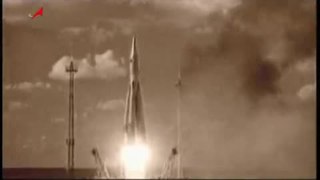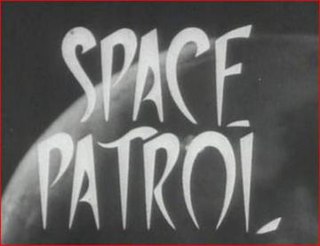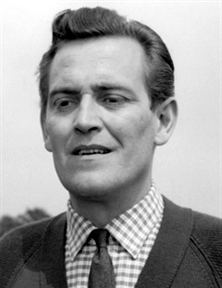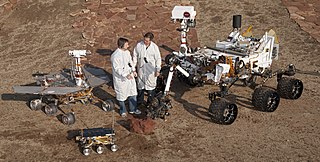Related Research Articles

Interplanetary spaceflight or interplanetary travel is the crewed or uncrewed travel between stars and planets, usually within a single planetary system. In practice, spaceflights of this type are confined to travel between the planets of the Solar System. Uncrewed space probes have flown to all the observed planets in the Solar System as well as to dwarf planets Pluto and Ceres, and several asteroids. Orbiters and landers return more information than fly-by missions. Crewed flights have landed on the Moon and have been planned, from time to time, for Mars, Venus and Mercury. While many scientists appreciate the knowledge value that uncrewed flights provide, the value of crewed missions is more controversial. Science fiction writers propose a number of benefits, including the mining of asteroids, access to solar power, and room for colonization in the event of an Earth catastrophe.

Space exploration is the use of astronomy and space technology to explore outer space. While the exploration of space is currently carried out mainly by astronomers with telescopes, its physical exploration is conducted both by uncrewed robotic space probes and human spaceflight. Space exploration, like its classical form astronomy, is one of the main sources for space science.

Journey Into Space is a BBC Radio science fiction programme written by BBC producer Charles Chilton. It was the last UK radio programme to attract a bigger evening audience than television. Originally, four series were produced, which was translated into 17 languages and broadcast in countries worldwide. Chilton later wrote three best-selling novels and several comic strip stories based upon the radio series.

A lander is a spacecraft that descends towards, then comes to rest on the surface of an astronomical body other than Earth. In contrast to an impact probe, which makes a hard landing that damages or destroys the probe upon reaching the surface, a lander makes a soft landing after which the probe remains functional.
Zond was the name given to two distinct series of Soviet robotic spacecraft launched between 1964 and 1970. The first series, based on the 3MV planetary probe, was intended to gather information about nearby planets.

The Discovery Program is a series of Solar System exploration missions funded by the U.S. National Aeronautics and Space Administration (NASA) through its Planetary Missions Program Office. The cost of each mission is capped at a lower level than missions from NASA's New Frontiers or Flagship Programs. As a result, Discovery missions tend to be more focused on a specific scientific goal rather than serving a general purpose.

The Soviet space program was the state space program of the Union of Soviet Socialist Republics (USSR), active from 1955 until the dissolution of the Soviet Union in 1991. Contrary to its American, European, and Chinese competitors, which had their programs run under single coordinating agencies, the Soviet space program was divided between several internally competing design bureaus led by Korolev, Kerimov, Keldysh, Yangel, Glushko, Chelomey, Makeyev, Chertok and Reshetnev. Several of these bureaus were subordinated to the Ministry of General Machine-Building. The Soviet space program served as an important marker of claims by the Soviet Union to its superpower status.

Space Patrol is a British science-fiction television series featuring marionettes that was produced in 1962 and broadcast from the beginning of April 1963. It was written and produced by Roberta Leigh in association with ABC Weekend TV.

Gerald Robert Flood was a British actor of stage and television.

Voyage is a 1996 hard science fiction novel by British author Stephen Baxter. The book depicts a crewed mission to Mars as it might have been in another timeline, one where John F. Kennedy survived the assassination attempt on him on 22 November 1963. Voyage won a Sidewise Award for Alternate History, and was nominated for the Arthur C. Clarke Award in 1997.

Commando Cody: Sky Marshal of the Universe is a 1953 twelve-chapter movie serial from Republic Pictures, which began life as a proposed syndicated television series. It consists of twelve 25-minute sequential episodes directed by Harry Keller, Franklin Adreon, and Fred C. Brannon. It stars Judd Holdren, Aline Towne, Gregory Gaye, William Schallert, Richard Crane, and Craig Kelly.

A rover is a planetary surface exploration device designed to move over the rough surface of a planet or other planetary mass celestial bodies. Some rovers have been designed as land vehicles to transport members of a human spaceflight crew; others have been partially or fully autonomous robots. Rovers are typically created to land on another planet via a lander-style spacecraft, tasked to collect information about the terrain, and to take crust samples such as dust, soil, rocks, and even liquids. They are essential tools in space exploration.

Discovery and exploration of the Solar System is observation, visitation, and increase in knowledge and understanding of Earth's "cosmic neighborhood". This includes the Sun, Earth and the Moon, the major planets Mercury, Venus, Mars, Jupiter, Saturn, Uranus, and Neptune, their satellites, as well as smaller bodies including comets, asteroids, and dust.
With the advent of robotic and human spaceflight a new era of American history had presented itself. Keeping with the tradition of honoring the country's history on U.S. postage stamps, the U.S. Post Office began commemorating the various events with its commemorative postage stamp issues. The first U.S. Postage issue to depict a U.S. space vehicle was issued in 1948, the Fort Bliss issue. The first issue to commemorate a space project by name was the ECHO I communications satellite commemorative issue of 1960. Next was the Project Mercury issue of 1962. As U.S. space exploration progressed a variety of other commemorative issues followed, many of which bear accurate depictions of satellites, space capsules, Apollo Lunar Modules, space suits, and other items of interest.

The Planetary Science Decadal Survey is a serial publication of the United States National Research Council produced for NASA and other United States Government Agencies such as the National Science Foundation. The documents identify key questions facing planetary science and outlines recommendations for space and ground-based exploration ten years into the future. Missions to gather data to answer these big questions are described and prioritized, where appropriate. Similar decadal surveys cover astronomy and astrophysics, earth science, and heliophysics.
Mars-Grunt, also known as Expedition-M, is a proposed robotic Mars sample-return mission. It was proposed to the Russian Federal Space Agency (Roscosmos) by the Russian Space Research Institute.

Caliban's War is a 2012 science fiction novel by James S. A. Corey. It is about a conflict in the Solar System that involves the polities Earth, Mars, the Asteroid Belt and the outer planets, and a powerful extraterrestrial biological von Neumann probe. The second book in The Expanse series, it was preceded by Leviathan Wakes. The third book, Abaddon's Gate, was released on June 4, 2013. One of eight short stories and novellas published by James S. A. Corey, entitled "Gods of Risk", takes place directly after the events of Caliban's War.
References
- ↑ Muir, John Kenneth (15 September 2015). A Critical History of Doctor Who on Television. McFarland. p. 9. ISBN 978-1-4766-0454-1.
- ↑ "Pathfinders in Space finally comes to DVD". wipednews.com. Retrieved 10 April 2012.
- ↑ Pixley, Andrew (2011). The Pathfinders in Space series guide. Network DVD.
- ↑ "Newman, Sydney. British Programming Executive/Producer". museum.tv. Retrieved 10 April 2012.
- ↑ "Pathfinders in Space / Pathfinders to Mars / Pathfinders to Venus". Televisionheaven.co.uk. Retrieved 10 April 2012.
- ↑ "Pathfinders in Space Trilogy". NetworkDVD.net. Retrieved 10 April 2012.